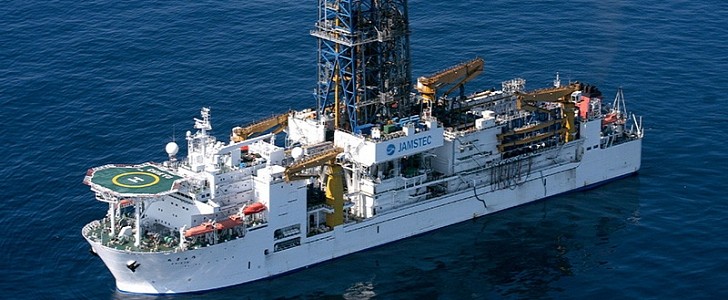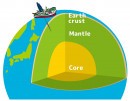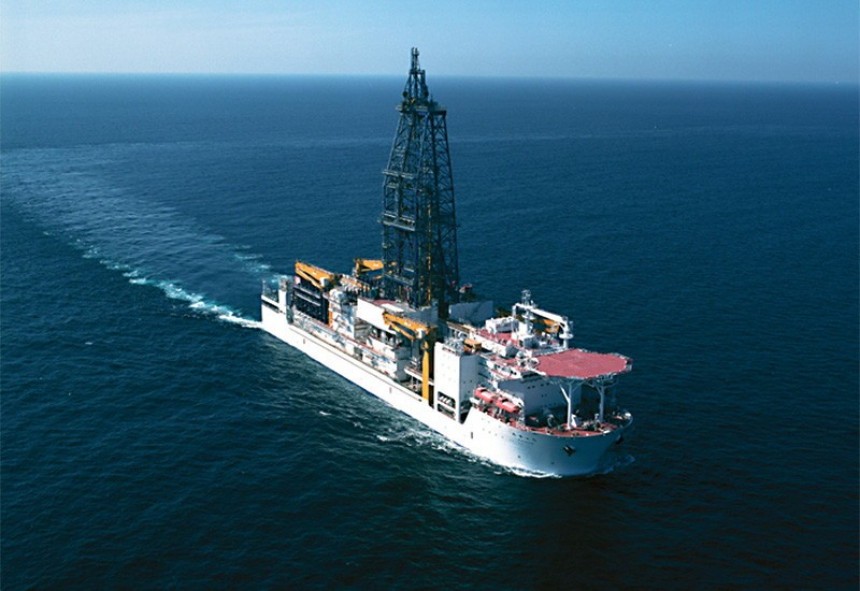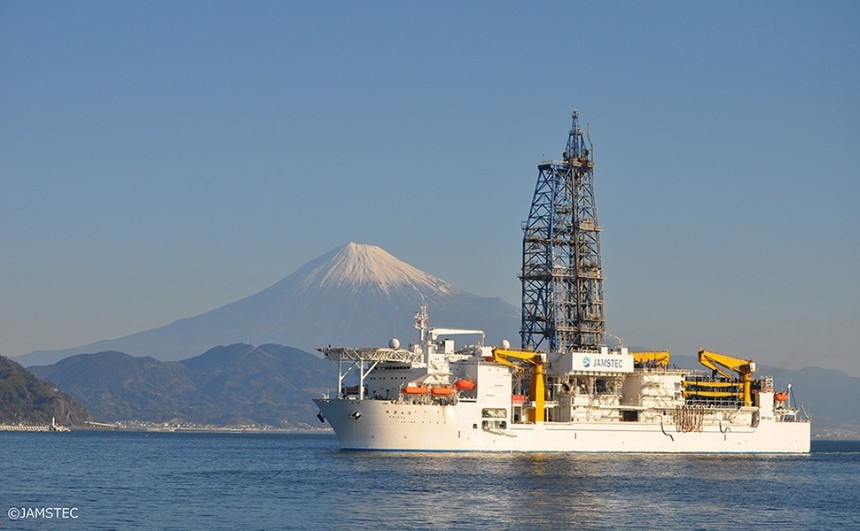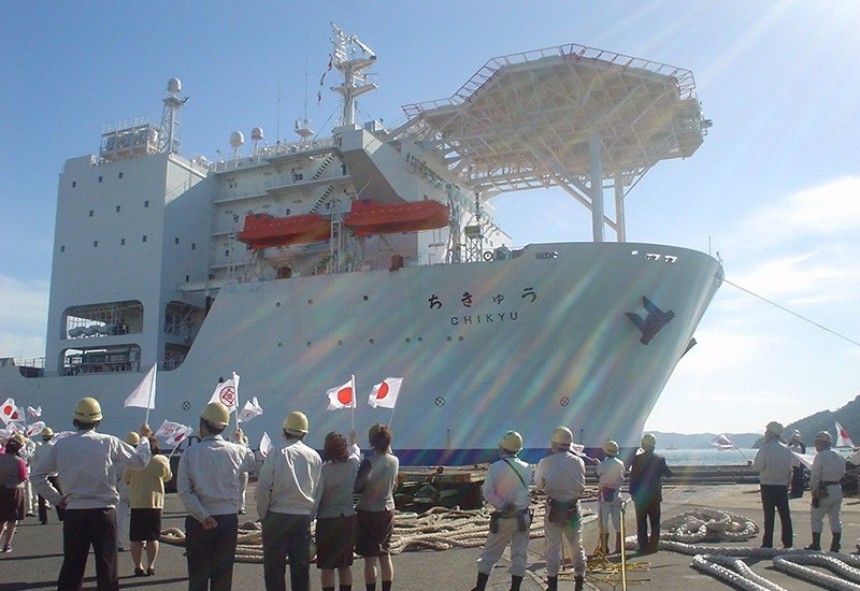This massive floating laboratory developed in Japan was the first to introduce the riser technology, inspired by the one used by oil rigs, to the world of scientific ocean drilling.
More than half a century ago, the scientific community embarked on one of the most ambitious projects of all time – the quest for the mantle. Most of what is known about the Earth’s crust, mantle, and core comes from observing and interpreting various data, but it can only be confirmed by getting pristine samples of the mantle. These can be obtained through drilling at incredible depths, and because the crust is the thinnest under the sea, ocean drilling is the way to go.
The International Ocean Discovery Program (IODP), an organization that was initiated more than 50 years ago, still hasn’t reached its main goal, that of collecting a sample from the boundary between the crust and the mantle, known as Moho (the Mohorovicic discontinuity), but it has completed the drilling of over 1,500 boreholes below the ocean, so far.
Researching the mysterious “flowing solid” is so important because it is considered to be the driving force behind crucial phenomena such as earthquakes and the deep carbon cycle that affects climate.
The vessel that has come closest to reaching this goal is Chikyu, the flagship of the Japan Agency for Marine-Earth Science and Technology (JAMSTEC) and the world’s first scientific research vessel equipped with riser drilling technology. Completed in 2005, it has participated in the Integrated Ocean Drilling Program since 2007 and in the IODP since 2013. In 2019, Chikyu established a world record for the deepest borehole drilled under the sea for scientific purposes.
The record was achieved in the Pacific Ocean, at Nankai Trough, off the Kii Peninsula in southwest Japan. According to JAMSTEC, this is one of the source regions of some of the most powerful earthquakes. The record-setting hole under the seafloor was 3.25 km-deep (2 miles). However, the deepest manmade hole is 12.2 km-deep (7.5 miles), a record that was obtained in 1994 by former Soviet Union scientists near the Russian border..
Japan built this record-setting ship as a way to contribute to Earth science – until the 2000s, the U.S. had led most of the scientific drilling projects. It took five years to complete the build of this innovative science ship. Its most distinctive feature was the rising drilling system, which connects the ship to the hole via a riser pipe. As Jamstec explains, this creates a closed system for drilling the mud, which makes the process safer and more efficient.
The vessel itself is a jaw-dropping floating laboratory. Chikyu (Japanese for “Earth”) was built by Mitsubishi Heavy Industries and meant to be able to drill as far as 7,000 meters (4.3 miles) beneath the sea into the tectonic plates.
With a length of 210 meters (689 feet) and a 38-meter (124 feet) width, Chikyu is as tall as a 30-floor building (130 meters/426.5 feet). It’s large enough to accommodate 200 people, including researchers, marine technicians, drillers, and the regular crew. In addition to borehole observation, the state-of-the-art onboard research laboratories conduct microbiological analysis and sampling processes.
Powered by a diesel-electric propulsion system, Chikyu can reach a maximum speed of 12 knots (13.8 mph/22 kph) and an outstanding range of 14,000 nautical miles (27,410 km, the equivalent of more than halfway around the world). Equipped with six main generators of 5,000 kW each, plus two auxiliary 2,500 kW ones, this massive vessel gets 35,000 kW of power, which would be enough to power a town with 10,000 inhabitants. It also boasts a helipad large enough for helicopters with a 30-passenger capacity.
Chikyu conducts the drilling operations through a top drive system. The drill string (almost three times longer than the Fuji Mountain) gets inside the water through a huge moon pool. According to JAMSTEC, the total lifting capacity is the equivalent of the power generated by 35 passenger cars (5,000 HP). Also, an automatic navigation system adjusts and maintains its position.
The massive science vessel was also built to withstand strong winds and waves and operate for at least five months at a time – this is how much drilling operations usually take. Throughout this time, supplies are delivered to it on-site, via boats and helicopters.
So far, JAMSTEC’s innovative ship has collected more than 1,000 geological samples known as cores, which provided important data for better understanding the Earth. But, although it has officially drilled the deepest hole beneath the seafloor, Chikyu hasn’t succeeded in reaching the hotspot where tectonic plates meet. The goal of the expedition was to go as deep as 5,200 meters (3.2 miles) but the drilling had to stop after 3,250 meters because the drill hole kept collapsing, Nature reports.
On the one hand, Jamstec saw that as a failure, considering that it was the culmination of a complex, almost decade-long process to drill deep into Nankai Trough. On the other hand, it did set a record for scientific ocean drilling.
Obtaining a sample of the mantle, this Holy Grail of geology, is still proving to be a challenging task, but a large-scale project could attempt that again in the coming years, using the lessons learned from Chikyu’s efforts. Scientific ocean drilling technology still needs to evolve, but the world’s first riser drilling vessel took a bold step towards uncovering the Earth’s mysterious past.
The International Ocean Discovery Program (IODP), an organization that was initiated more than 50 years ago, still hasn’t reached its main goal, that of collecting a sample from the boundary between the crust and the mantle, known as Moho (the Mohorovicic discontinuity), but it has completed the drilling of over 1,500 boreholes below the ocean, so far.
Researching the mysterious “flowing solid” is so important because it is considered to be the driving force behind crucial phenomena such as earthquakes and the deep carbon cycle that affects climate.
The vessel that has come closest to reaching this goal is Chikyu, the flagship of the Japan Agency for Marine-Earth Science and Technology (JAMSTEC) and the world’s first scientific research vessel equipped with riser drilling technology. Completed in 2005, it has participated in the Integrated Ocean Drilling Program since 2007 and in the IODP since 2013. In 2019, Chikyu established a world record for the deepest borehole drilled under the sea for scientific purposes.
Japan built this record-setting ship as a way to contribute to Earth science – until the 2000s, the U.S. had led most of the scientific drilling projects. It took five years to complete the build of this innovative science ship. Its most distinctive feature was the rising drilling system, which connects the ship to the hole via a riser pipe. As Jamstec explains, this creates a closed system for drilling the mud, which makes the process safer and more efficient.
The vessel itself is a jaw-dropping floating laboratory. Chikyu (Japanese for “Earth”) was built by Mitsubishi Heavy Industries and meant to be able to drill as far as 7,000 meters (4.3 miles) beneath the sea into the tectonic plates.
With a length of 210 meters (689 feet) and a 38-meter (124 feet) width, Chikyu is as tall as a 30-floor building (130 meters/426.5 feet). It’s large enough to accommodate 200 people, including researchers, marine technicians, drillers, and the regular crew. In addition to borehole observation, the state-of-the-art onboard research laboratories conduct microbiological analysis and sampling processes.
Chikyu conducts the drilling operations through a top drive system. The drill string (almost three times longer than the Fuji Mountain) gets inside the water through a huge moon pool. According to JAMSTEC, the total lifting capacity is the equivalent of the power generated by 35 passenger cars (5,000 HP). Also, an automatic navigation system adjusts and maintains its position.
The massive science vessel was also built to withstand strong winds and waves and operate for at least five months at a time – this is how much drilling operations usually take. Throughout this time, supplies are delivered to it on-site, via boats and helicopters.
So far, JAMSTEC’s innovative ship has collected more than 1,000 geological samples known as cores, which provided important data for better understanding the Earth. But, although it has officially drilled the deepest hole beneath the seafloor, Chikyu hasn’t succeeded in reaching the hotspot where tectonic plates meet. The goal of the expedition was to go as deep as 5,200 meters (3.2 miles) but the drilling had to stop after 3,250 meters because the drill hole kept collapsing, Nature reports.
Obtaining a sample of the mantle, this Holy Grail of geology, is still proving to be a challenging task, but a large-scale project could attempt that again in the coming years, using the lessons learned from Chikyu’s efforts. Scientific ocean drilling technology still needs to evolve, but the world’s first riser drilling vessel took a bold step towards uncovering the Earth’s mysterious past.
